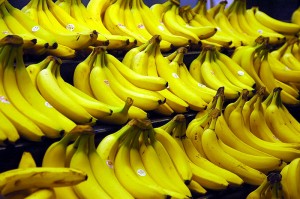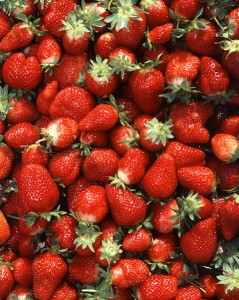Yesterday morning a friend drove into town from the far-flung suburbs so we could visit the downtown farmer’s market together. People say this is the best farmer’s market in the city. The ones I’ve seen in other parts of town have been a bit lackluster, more crafts fair than produce market, so I was curious to see what “the best” means, particularly since other bloggers say they get good deals on local produce at these operations.
Getting there was a challenge: you have to navigate the new train tracks and a labyrinth of one-way streets—the City has kindly made a nightmare of driving downtown. Parking, at least, was free: in a graveled lot with no markings, overrun by people scrambling to get space between cars left sitting cattywampus, higgledy-piggledy and willy-nilly. My friend found a paved lot, where she parked in an end space; when we went back to leave some of her purchases in the car while we walked to a restaurant, someone had parked a pickup with an extra-long truck bed at right angles to her vehicle, blocking her exit. Fortunately, the space next to her was empty, so she wriggled her car out and reparked it in that spot. While she was backing out, two drivers came along and tried to grab the empty space; if I hadn’t been standing in it, they would have blocked her from getting her car out.
We enjoyed walking around. It was a stunningly beautiful day, cool and clear. The downtown area is gentrifying apace—or it was, until the Bush economy collapsed. Strips of old, formerly abandoned 1940s stores have been renovated and repopulated with new shops, and great blocks of so-called “lofts” fill former empty lots and the sites of demolished flophouses. In downtown Phoenix, a “loft” is an overpriced condominium apartment, less overpriced now that no one can or will buy them but still out of most buyers’ reach. Sadly, the area is still populated with homeless mentally ill people living on the streets, the first and worst symptom of America’s ailing healthcare system. As I was leaving, a particularly desperate panhandler came after me and would not stop pestering me even after I got into the car and locked the door.
The farmer’s market offered more produce and preserves per square yard than others here in Arizona, but about half the booths were occupied by people selling tie-dyed shirts, crocheted scarves, wood carvings, pottery, handmade soap, lost-wax metalwork, bead jewelry, and on and on. Prices didn’t strike me as much of a bargain, considering that a raft of middlemen supposedly are cut out of the marketing process.
I bought 2.5 pounds of tomatoes—a handful of vine tomatoes, two heirlooms, and two green tomatoes that I intend to fry for breakfast this morning—for $7.39. That was not a bad price: $2.95 a pound; unclear whether these were organic, but they didn’t appear to be. Potatoes and sweet potatoes were a dollar a pound. We came across a lady selling some exceptionally delicious hummus; I proposed to buy a container of that for $3.00 and a bag of pita chips for $6.00. On second thought, though, after the vendor mentioned that the stuff didn’t contain any tahini but really was just puréed chickpeas, garlic, and olive oil, I decided nine bucks was a little much for a can of beans and a bag of chips, especially since I have a perfectly fine food processor sitting in my kitchen.
After my friend and I parted, I wondered idly how some of the prices we’d encountered would compare with with grocery-store prices. So, on the way home I stopped by AJ’s (my favorite gourmet emporium and home of the Elegantly Overpriced Commodity) and Safeway (itself no bargain corner).
At AJ’s, vine tomatoes were selling for $2.99 a pound; green tomatoes, a rarity in stores here, were offered for $3.99. Campari tomatoes, the variety I buy because they are the only tomatoes with anything resembling flavor available in this part of the country, were $4.99. Pita snacks ran from $6 to $20 for a package. AJ’s carries our vendor’s hummus: $4.99, two bucks more than buying it directly from its maker at the farmer’s market. Potatoes were $1.49 a pound.
At Safeway, I couldn’t find pita chips, but a package of pita bread sold for $2.19 for ten pieces; easy enough to paint it with olive oil, cut it into triangles, and crisp in the oven. A can of chickpeas cost all of $1.39 for organic and $1.00 for nonorganic. Campari tomatoes were selling for the same price as AJ’s; vine tomatoes were $2.69 a pound. Neither store had any heirloom tomatoes. Sweet potatoes were $1.29 a pound, but regular Idaho potatoes went for 5 pounds for 99 cents—about 25 cents a pound.
Okay. Given that you’d have to make your own hummus (a process that would take all of about 5 minutes) and substitute bread, toast, or tortilla chips if you didn’t want to dork with cutting up and toasting pita bread, let us compare the costs:
Hummus:
Farmer’s market: 3.00
Gourmet market: $4.99
Safeway DIY ingredients: $1.00 plus a few drops of olive oil and lemon juice
Tomatoes:
Farmer’s market: 2.95 a pound
Gourmet market: $2.99 to $3.99 a pound
Safeway: $2.69 a pound
Potatoes:
Farmer’s market: $1.00 a pound
Gourmet market: $1.49 a pound
Safeway: 25 cents a pound
Pretty consistently, the Safeway underpriced the farmer’s market and the AJ’s on the goods I was prepared to purchase this weekend.
Even where the farmer’s market was a few cents cheaper, one has to question the cost of the hassle factor: shopping there requires a significant investment of time. The site was so crowded and so cluttered with sellers of kitsch that it was hard to make your way to the food stands. To buy something, you were supposed to get a slip of paper on which each of your desired purchases was marked, go to a central cash collection site to pay, and then take the receipts back to each of the vendors you’d visited. This would entail elbowing your way to the desired vendors and standing in line not once, not twice, but three times for each purchase you made!
Fortunately, some of the vendors would take cash and credit cards. Just as fortunately, the hummus vendor did not, and the prospect of dorking around in two more lines deflected me from making that impulse buy. In terms of gasoline expended, the Safeway is a third as far from my house as is downtown; the AJ’s is half as far. And no panhandlers harassed me in either grocer’s parking lot.
For a special outing, it was fun. But day by day, it’s not a venue I would add to my regular round of places to buy groceries.




